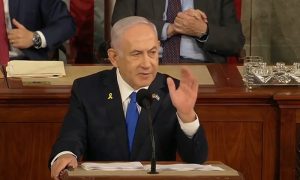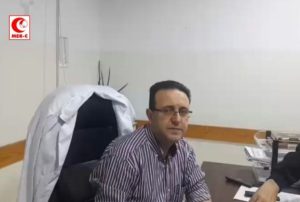 by Parni Hadi*
by Parni Hadi*
Who change the world? The answer is: young people and media. Young people are identical with change. Youth has been always spearheads for a change any time, any where. Young people are changers in local, national and global levels. Be it in political, social and cultural fields. Young people are known for their strong will, lack of patience, desiring whatever they want come into being immediately. Young people are aspiring for the future., anti establishment. They are revolutionaries compared to older people who tend to be statusquoers.
A change often causes conflict. How can we make a change without causing unnecessary conflicts? The conflict can be easily accelerated to become worst uncontrollably due media reports, moreover in the present digitalized, interned-based information society. On the contrary, media can alo help revolutionary young people achieving their goals as well as controlling conflicts and reconciling warring parties. Therefore, young people should understand ways how to deal with media.
NEW EMERGING FORCES
Also Read: Boycott of Zionism, The Most Powerful Weapon
Digital technology has developed internet-based communications as the latest state of the art of communications technology. The interned-based social media, including Facebook and Twitter, dubbed as “new” media, have become a new player as well as a new center of power, leaving behind the “old” media (newspapers/magazines, radio and television stations).
The new media have enabled almost all people, particularly young people to be journalists, preachers, teachers, opinion makers and “content providers” that can publish and broadcast their ideas directly. The new individual “content providers” through their social networks have become “new emerging forces”, “old established forces”.
The “new” emerging media have been developing rapidly with an ever growing influence in the ideological, political, social and economic fields throughout the world. They have prompted democratization process, forcing the downfalls of long-serving rulers of a number of Muslim countries in the Middle East. What is continuing to happen in the Middle East now, where some rulers are threatened to step down, has given us an invaluable lesson learnt: Technology and Democracy are closely related and unstoppable!
Technology and Democracy have great influences on how people communicate. Technology has made messages reach the target more easily (cheaper and faster). Democracy has enabled people to express and communicate their dreams, ideas and hopes without fear of being punished by rulers and leaders. More sophisticated technologies make communications easier, faster and cheaper. More freedom of expression as a product of democracy produces more ideas. Less technology and less democracy make communications difficult, blocking ideas to come out.
Also Read: Nuclear Technology: Harm and Benefit from the Qur’anic Perspective
Realizing that Technology and Democracy are very closely related and unstoppable, the Muslim World has no other choice now but mastering the digital technology and promoting democracy, which gives more freedom of expression.
Life without freedom of expression is obsolete and old fashioned, but “too much” freedom or “freedom without boundaries” exercised by journalists and media, particularly the social media, has negative impacts on the population as shown by moral decadence of the younger generations, which is attributed by “older generations” to free access to pornography websites. But CORRUPTION done by “older generations” is not less dangerous than pornography.
PEACE JOURNALISM

Also Read: Gaza Cries Out, the World Stays Silent: A Wounded Humanity
Media, old and new, are using or trading words and pictures to reach their objectives. For the purpose of peace, the selection of words and pictures to be broadcast or published is of vital importance. A simple advice, just avoid provocative words and pictures that can stimulate anger. On the contrary, choose words and pictures that can prompt positive responses. Diction, time of publication and target audience must be carefully considered. Use humors and caricatures that can easily invite immediate smile and laughter.
Features with consoling topics of love, beauty, women and children plus relevant jokes and related attractive photos must be given top priority, rather than hard political or economic straight news. When there is an error in the publication, make rectification honestly soonest.
Invite both sides of the conflicting parties to exchange words and photos through your media.
If we think after some times the warring parties have reached common understanding, mutual interests and mutual respects, you could invite them to meet face to face in a relaxed and funny social gatherings. Song festival, culinary, fashion and cultural shows with the partiicipation of leaders of both parties are highly recommended. Friendship sport competitions are also recommendable.
Also Read: Indo Defence Expo and Forum; Sharing Responsibility of Humankind and Environment
This kind of practices is named peace journalism. Peace journalism is seeking for peaceful solutions accepted by the conflicting parties. Peace is the ultimate goal of this journalism. Young people as peace builders and peace keepers should applly peace journalism by using “old” media and “media”.
PROPHETIC JOURNALISM
Seeking for solutions for establishing peace by making a change for better and more favourable conditions is “ibadah”, serving Allah, God the Almighty. In the Islamic world it can be done by da’wa or propagating noble values and appeals for Taqwa, complete obedience to Allah, by means of doing goodness and avoiding wrongdoings (amar ma’ruf nahi munkar) based on Holy Quran and Hadits. Da’wa is an act of mass communications, in which journalism and mass media play a significant role.
The technology used and the level of prevailing democracy shown by the freedom of the press, affect the quantity, quality and impacts of the da’wa. It is already proven that in the modern era, da’wa through mass media is the most effective one. “Old” established professional and authoritative preachers as da’wa key players are now challenged by new emerging non certified preachers who broadcast their messages through “new” media.
Also Read: Safiya Saeed: From Somali Migrant to First Hijab-Wearing Mayor of Sheffield
It is true that da’wa in the presence of multi-players of communications is facing ever growing challenges of balancing Modernity due to technology and democracy and Morality based on Al Quran and Hadits. To answer those challenges, I suggest that “old” established, professional and authoritative preachers should develop themselves to become new content providers who publish and broadcast their messages through “new” media too. Then, the council of ulemas (Moslem scholars) should embrace the self-styled new, non certified preachers to join hand in hand with the professional ones.
In the use of media, “old” and “new”, I propose those content providers to actuate “Prophetic Journalism”. All journalists, regardless their religions, racial, social and cultural backgrounds and nationalities are carrying out the duties of the prophets. The Holy Quran says: all prophets have no other obligations, but carrying good news and reminders of their followers to do good things and avoid evil doings (amar makruf and nahi munkar)..
For Moslem journalists and content providers, there is already perfect guidelines, namely the four excellent characters of Prophet Mohammad ( Peace be upon Him):
a. Sidiq (revealing Truth),
Also Read: Why Food Safety is Essential During Hajj Services?
b. Tabligh (disseminating Truth in an educational way)
c. Amanah (reliable, trustworthy and accountable)
d. Fathonah (with wisdom or wisely).
Prophet Mohammad in his da’wa combined His Words and Deeds. He did what He said. It must be admitted that many leaders, preachers and media professionals in the Muslim World have not yet implemented what Prophet Mohammad had said and done. Too many words, less action or even worse: their actions are contradictory to what they say. Critics say that many leaders, preachers and teachers can give examples, but they are not yet able to transform themselves to be examples. Corruption which is rampant in some Muslim countries is a vivid example.
Also Read: Indonesia Sign Language Mushaf Qur’an; A Sustainable Gift in Celebrating Pancasila Birthday
Actuating Prophetic Journalism by means of practicing the four excellent characters of Prophet Mohammad for Islamic journalists and content providers is urgent now. The basic fundamental of Prophetic Journalism is Love, emanating from Allah, the Supreme LOVE Himself. Thus, prophetic journalists and content providers would show dignity, devotion, tolerance, mutual understanding, mutual respect, non violence and tender loving care in their reports, features and commentaries.
The four characters of Prophet Mohammad due to their universal noble values have been incorporated in the Code of Conducts of Journalists everywhere, including Islamic, other religion-based and secular content providers. The practice of journalism worldwide indicates that most men and women working in the media are motivated by “a call from within”, a spirit to serve a cause higher than the commercial goals of their news organizations or any other worldly rewards. Peace journalism is part of or in line with prophetic journalism.
Prophetic Journalism would give optimal results if the following conditions prevail:
- a. Freedom of expression, no oppression by whosoever, government and religious authorities as well as the media owners. Freedom prevails only in a democratic society. Freedom will result in the presence of:
- b. Independence (Objectivity), a condition to reveal:
- c. Truth. It is truth that everyone would like to see. But it is not just for the sake of truth, it must be dedicated to:
- d. Justice/Fairness. Truth must be the basis for social justice. It is social justice that will produce:
- e. Prosperity, economic and social well beings, which in turn will yield:
- f. Peace. It is peace of mind that everyone is seeking for. But, it must be not just a personal, local, national peace, it must be dedicated to:
- g. Global peace where Humanity based on universal noble values could flourish, getting along with Islamic principles, which are “rahmatan lil alamin” (Blessing for all creatures).
PRACTICAL SUGGESTIONS
Also Read: Leila Khaled, The Icon of Palestinian Women’s Resistance
Based on my personal engagement with the media and social activities plus my observation of best practices, the following are some practical suggestions:
1. Journalism is the practice of collecting, processing (editing) and disseminating information. Journalism and mass media play a very important role in mass communication, including da’wa. Messages from leaders, preachers, ulemas, scholars and other resource persons are communicated effectively to followers, audience, listeners and public at large as well as their responses by mass media after being processed and transformed by journalists into information.
Suggestion: be friendly with journalists and their media!
2. Information is a product which is loaded with ideological, political, economic, social and cultural values and interests by its provider (mass media). Thus, information is not value-free and not-interest free. It depends on the provider’s values and interests, who may have also listened to and accommodated the values and interests of the target audience (readers, listeners and viewers), advertisers (mostly for commercial media), audience’s responses (including supports, complaints and or protests).
Also Read: The Twilight of the Zionist Israeli State
Suggestion: involve yourselves in the production of information as journalists, writers, contributors, speakers, publishers and owners of news organizations!
3. Message (Content) and Means of dissemination (Technology) are believed to be of equal importance. But lately it is proven that the Message is more important than the Means. Even, in the discourse of “old” and “new “media, it is widely accepted that Content is the King. The reason is that Technology can be more easily produced, reproduced, copied (pirated), adopted and adapted, while content production involves intellectual, emotional and spiritual capabilities of human being, which is unique and in some cases mysterious, unexplainable.
Suggestion: control the content providers by providing our own version!
4. The “new” media, which include internet-based multimedia such as mobile phone, facebook, twitter, Iphone and Ipad, give unlimited opportunities for everyone to be a content provider. Both “old” and “new” media are Content Providers. Most important players in content production are journalists (reporters/contributors and editors). Since its emergence, mass media has become “Rulers” of the societal life worldwide, moreover in the present digital era, where interned-based social media are preoccupying and dictating our modern lives, especially for the younger generation.
Also Read: Prof. Abdul Fatah El-Awaisi and the Intellectual Roadmap for the Liberation of Al-Quds
Suggestion: provide and deploy more professional content providers for “old” and “new” media through education/trainings!
5. Realizing the most important role of content providers, the cultivation of noble values through continuous systematic lifelong education, including da’wa, is a MUST.
For Muslim journalists there is no other better choice than adopting the four excellent characters of Prophet Muhammad by means of practicing and propagating Prophetic Journalism.
Suggestion: include Prophetic Journalism in the curriculum of our schools of communications and journalistic training centers.
6. The invention of Internet, mobile phone and Iphone has prompted the birth of Citizen Journalists or Citizen Content Providers. Digital Technology has helped speeding up the spreading of as well as democratizing information. The emergence of digital communications technology has posed a serious challenge to those regarded “old” media to compete with the “new” media. Technology has shaped and shifted media form, appearance and way of presenting information. To keep up the pace of technological development, owners of “old” media develop their news organizations into a convergent multi-media, offering “three in one” services: text, audio and video.
Suggestion: develop convergent media
- 1.Judging by its legal status, there are now:
- 2.State/government media
- 3.Private/commercial media
- 4.Personal/social media
The first two are run by bureaucrats and professionals, while the third is free, run by individuals as citizen content providers, adopting citizen journalism.
Many state/government-controlled media are facing serious challenges posed by commercial and more over by social media. Lack of freedom of expression and bureaucratic procedures have caused state/government media left far behind by private/commercial media and even more by social media in speed of distribution and style of presentation.
Suggestion: apply good corporate governance.
8. It is admitted that social media mostly lack in accuracy, though many big news organizations run by professional journalists often quote personal/social media as initial source or clue of information. Due to lack of professionalism, citizen content providers often face difficulties in feeding readers with constant, timely news. Of course, in some particular cases, especially in reporting local disasters, citizen journalists are much faster than the so-called professionals hired by news organizations.
Suggestion: involve citizen journalists in our training programs
9. Combined Da’wa: words (written and spoken) must be coupled with concrete empowerment programs. Peace builders and peace keepers should write and speak in the media and directly to the audience through regular gatherings as well pioneers and social volunteers to help the Poor in the urban slums and less developed, isolated rural areas with concrete, benefitting actions.
Suggestion: do combined da’wa
10. Triple C Principle. For the success of da’wa, there must be synergy of professional, organized content providers and citizen journalists. Cooperation, Competition, instead of Confrontation are the key words. This triple C principle is also valid in dealing with international, secular, commercial news organizations and citizen content providers.
Suggestion: avoid unnecessary frictions and confrontation
11 Keys to success for content providers, including preachers, in the digital era. Methods/arts of presentation should be:
- 1.Actual,
- 2.Personal
- 3.Fashionable
- 4.Interactive (dialogue), instead of monologue, imposing indoctrination
- 5.Informing, so people know
- 6.Educating, so people understand
- 7.Entertaining, so people are at ease, relaxed, relieved
- 8.Enlightening, so people are spiritually peaceful
- 9.Empowering, to enable people to actualize their respective potentials for their happiness
12. Strategy to achieve objectives:
- 1.Adopt and apply best practices of Prophetic Journalism
- 2.Continuous education and trainings for character building based on noble characters of Prophet Mohammad and mastering communications technology
- 3.Cooperation and Competition for the sake of goodness (fastabiqul khairat), instead of Confrontation (Triple C principle).
- 4.Establishing national and regional training centers, opened to professional and citizen content providers, offering Prophetic Journalism lessons.
- 5.Setting up of “ old “and “new media” and production houses for text, audio and video
- 6.Free flow of information for exchange of contents
- 7.Setting up a clearing house/center for solving disputes
- 8.Less dependent on outside resources
- 9.Combining words and deeds. Do what you say!
CONCLUSION
Young people as agents for peace should apply digital technology, interned-based “content providers”, because they give more opportunities and advantages for building peace rather than adversaries and disadvantages. The bigger the challenges we face, the bigger the opportunities we have. There is always a room for optimism and innovation. “Old” and “New” forces should unite with Dignity for Devotion to Allah through concrete actions dedicated to establish a peaceful and more prosperous world for the benefit of human beings and all creatures. May Allah bless us. Amien.
(T/PH/E01)
Mi’raj Islamic News Agency (MINA)

*Senior Journalist, Founder of Dompet Dhuafa





























 Mina Indonesia
Mina Indonesia Mina Arabic
Mina Arabic